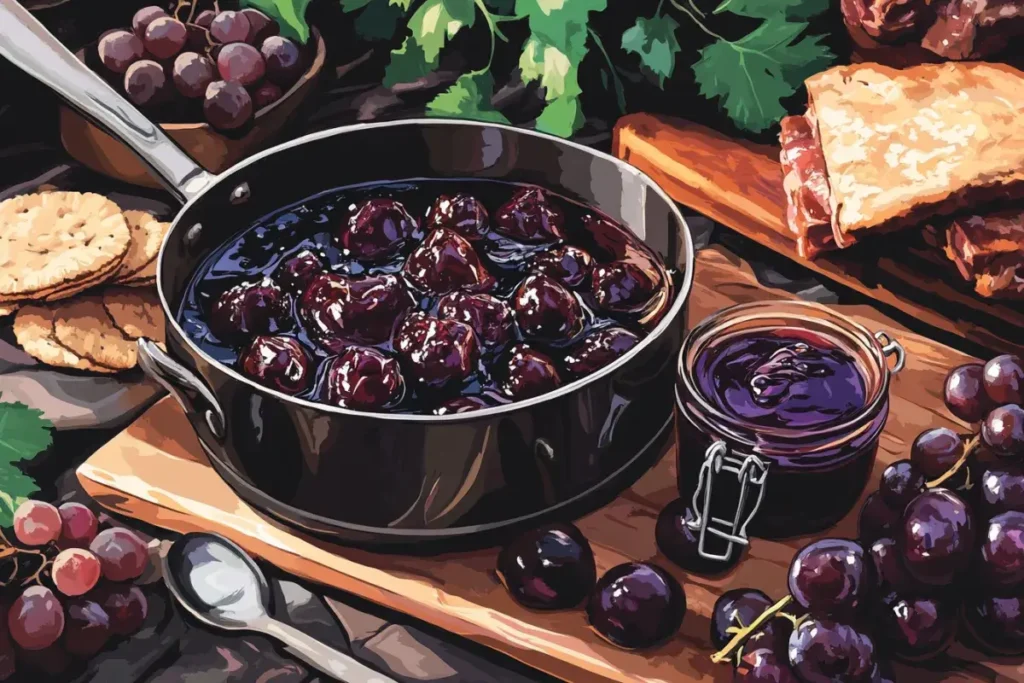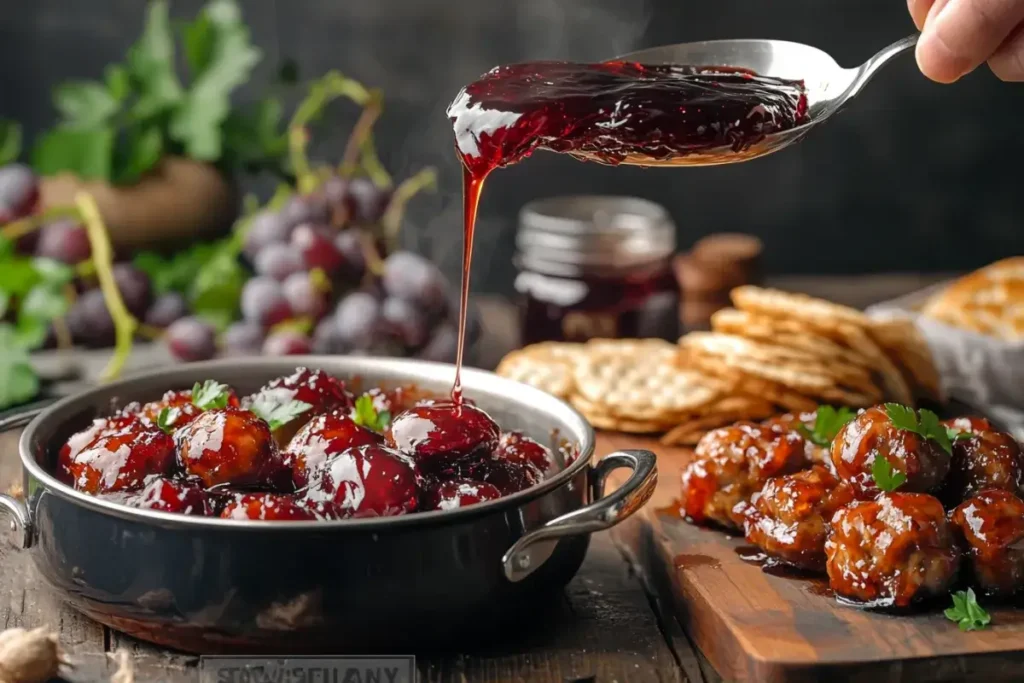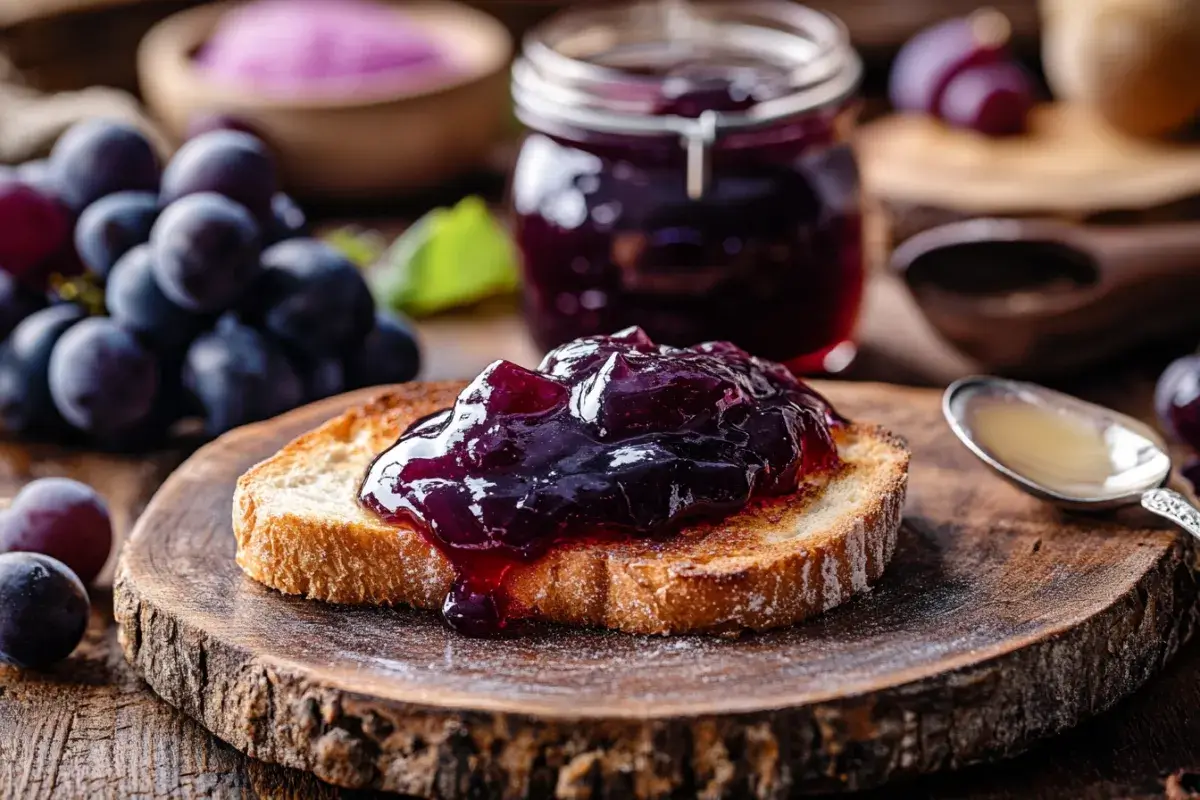Grape jelly remains a beloved staple in many households, commonly enjoyed on toast and sandwiches. Its sweet and tangy flavor makes it a versatile ingredient in various recipes. But have you ever wondered what exactly goes into making this jelly? Whether you’re considering homemade options or curious about the ingredients in store-bought varieties, understanding the composition of grape jelly helps you make more informed choices about your food.
Grape jelly has a rich history that spans centuries. Over time, it evolved from a simple homemade preserve into a commercially manufactured product available in countless brands and variations. Whether you prefer traditional Concord grape jelly or sugar-free alternatives, knowing what it’s made of can deepen your appreciation for it.
What is Grape Jelly Made Of?
At its core, grape jelly uses a few simple ingredients: grapes, sweeteners (usually sugar), pectin, and acid. These components come together to create the smooth, gel-like texture we all associate with jelly. While some jellies include preservatives and additives, the basic recipe remains consistent.
Let’s break down each of the primary ingredients and explore why they are essential to the jelly-making process.
Main Ingredient: Grapes
Grapes take center stage in grape jelly. Most commonly, Concord grapes contribute to their strong flavor and deep purple color. However, other grape varieties can also be used, each providing a unique taste.
Types of Grapes Used in Grape Jelly
- Concord Grapes: The go-to choice for grape jelly, known for their robust flavor and high pectin content, making them ideal for jelly-making.
- Other Varieties: Muscadine or seedless red grapes can also serve as the base, though they produce a slightly different taste and texture.
Nutritional Value of Grapes in Jelly
Grapes pack a punch with antioxidants, vitamins, and minerals that benefit your health. Rich in vitamin C and polyphenols, grapes support immune health and fight inflammation. While the jelly-making process removes most of the grape’s fiber, it retains many vitamins and antioxidants, making grape jelly a relatively nutritious spread when consumed in moderation. You can find more on the health benefits of grapes here.
Are Grape Varieties Important?
Yes, the type of grape used significantly affects the final product. Concord grapes, with their strong flavor and high natural pectin, result in a firmer, more flavorful jelly. Other grapes produce softer, milder jelly. The choice of grape ultimately depends on personal preference, but each variety brings its own benefits.
Sweeteners: Sugar and Alternatives
Sugar plays a crucial role in the jelly-making process, not only for sweetness but also as a preservative that helps the jelly maintain its texture and prevents spoilage.

Traditional Sugar Content
Most grape jelly recipes rely on granulated sugar as the primary sweetener. Sugar works with pectin to create the jelly’s firm, spreadable consistency. Without sugar, the jelly wouldn’t set properly, resulting in a runny texture. Additionally, sugar balances the tartness of the grapes, enhancing the overall flavor.
Natural Sweeteners in Grape Jelly
For those who prefer more natural alternatives to refined sugar, options like honey and agave syrup work well. While these alternatives provide a different flavor profile and slightly alter the texture, they can still produce a delicious grape jelly. However, they may not offer the same firm consistency that sugar provides.
Low-Sugar Grape Jelly Options
Many people today aim to reduce their sugar intake, which led to the rise of low-sugar and sugar-free grape jelly options. These versions use less sugar or alternative sweeteners like stevia to achieve sweetness without the high calorie count. Although the taste and texture may differ slightly, these jellies offer a good option for those mindful of sugar consumption.
Pectin: The Gel-Like Substance
Pectin, a naturally occurring fiber in fruit, plays an essential role in jelly-making because it helps the mixture solidify and form a gel-like consistency.
What is Pectin?
Pectin thickens grape jelly, giving it the signature smooth texture. Without pectin, the jelly would remain a thin liquid, unable to hold its shape. Grapes naturally contain pectin, especially Concord grapes, but many recipes call for added pectin to ensure the jelly sets properly.
Natural vs. Commercial Pectin
There are two main types of pectin used in jelly-making:
- Natural Pectin: Extracted from fruits like apples and citrus peels. Natural pectin requires high sugar content and acidity to work effectively.
- Commercial Pectin: Processed and concentrated, this type works more reliably and even in low-sugar recipes. You’ll typically find it sold in powdered or liquid form.
How to Make Grape Jelly Without Pectin
For those preferring an all-natural approach, you can make grape jelly without using commercial pectin. By simmering the grapes for a longer time, their natural pectin releases, though the result may yield a softer, less firm jelly.
Acid: The Tangy Element
Acid plays a vital role in balancing the sweetness of grape jelly and ensuring the proper chemical reaction between sugar and pectin.
The Role of Citric Acid in Grape Jelly
Most recipes use citric acid or lemon juice to provide the necessary acidity. This acid helps pectin work effectively, ensuring the jelly thickens properly. Additionally, the acid prevents the jelly from becoming too sweet by cutting through the sugar’s richness and adding a subtle tang to the flavor.
Other Natural Acid Sources
Some recipes swap citric acid for lemon juice, a natural alternative. Lemon juice adds a fresh, tart note that complements the sweetness of the grapes. Regardless of the acid source, it’s crucial for ensuring the jelly sets and has the desired flavor.
Grape jelly, despite its simplicity, offers a delightful combination of grapes, sugar, pectin, and acid. Each ingredient plays a vital role in creating the perfect texture and flavor balance. Whether you choose traditional Concord grape jelly or opt for low-sugar alternatives with natural sweeteners, understanding these ingredients helps you appreciate this classic spread even more.
How is Grape Jelly Made?
Making grape jelly is a straightforward process that involves just a few key steps, whether you’re preparing it at home or it’s mass-produced in factories. Though the ingredients are simple, the technique behind creating jelly requires precision to achieve the perfect texture and flavor.
Traditional Method of Grape Jelly Making
The traditional method for making grape jelly starts with extracting juice from the grapes. Here’s how the process unfolds step by step:
- Juicing the Grapes: Start by washing and crushing the grapes. The crushed grapes are then cooked to release their juices. Some people strain the mixture through cheesecloth or a jelly bag to remove skins and seeds, leaving only the juice.
- Adding Sugar and Pectin: Once the juice is ready, you add sugar and pectin. The sugar adds sweetness while pectin ensures the jelly will set properly.
- Boiling the Mixture: The next step involves boiling the juice, sugar, and pectin mixture. Boiling activates the pectin, causing the jelly to thicken. Stirring continuously is essential to prevent the mixture from burning.
- Testing the Set: After a few minutes of boiling, you can test whether the jelly will set. Spoon a small amount onto a chilled plate and let it cool for a few seconds. If the jelly wrinkles when pushed, it’s ready.
- Canning and Sealing: After achieving the desired consistency, the jelly is poured into sterilized jars and sealed while hot. This prevents any bacteria from entering and spoiling the jelly. If done correctly, the jelly will remain fresh for months.
Commercial vs. Homemade Grape Jelly
The primary difference between commercial and homemade grape jelly lies in the ingredients and methods used. Commercial jellies often include added preservatives, colorings, and artificial sweeteners to ensure a longer shelf life and consistent flavor. Additionally, manufacturers usually make jelly in bulk, using industrial equipment to process and bottle it efficiently.
In contrast, homemade grape jelly often uses fewer additives and relies more on natural ingredients like fresh grapes and natural pectin. This can result in a fresher, more flavorful product. Homemade jelly also allows for more customization, such as using less sugar or incorporating alternative sweeteners.
Common Mistakes in Grape Jelly Making
Even with simple ingredients, making grape jelly at home can lead to some common pitfalls:
- Overcooking the Jelly: Cooking the mixture for too long can result in a tough or overly thick jelly. It’s crucial to monitor the consistency and perform the set test regularly.
- Not Adding Enough Pectin: Without sufficient pectin, the jelly won’t set properly and will remain runny. Always follow the recipe’s instructions on pectin measurements.
- Improper Sealing: If you don’t seal the jars properly, the jelly could spoil. Always ensure the jars are sterilized and sealed tightly to maintain freshness.
Store-Bought vs. Homemade Grape Jelly
There’s often a debate about whether store-bought or homemade grape jelly is better. Each has its pros and cons, depending on what you’re looking for.
Additives and Preservatives in Commercial Grape Jelly
Many store-bought grape jellies contain high-fructose corn syrup, which is a cheaper alternative to sugar. Some brands also include artificial colorings and flavorings to enhance the product’s appearance and taste. While these additives ensure a longer shelf life and consistent flavor, they may not appeal to everyone, particularly those looking for more natural options.
Why Homemade Grape Jelly Tastes Different
When you make this jelly at home, you’re likely using fresh, high-quality ingredients, which can result in a more intense and authentic grape flavor. Homemade jelly often contains fewer additives, which allows the natural sweetness of the grapes to shine through. Since it’s made in small batches, the freshness and texture are often superior to mass-produced versions.
Grape Jelly Variations
Grape jelly doesn’t always have to be one-note. There are plenty of ways to switch it up and experiment with different flavors and ingredients.
Flavored Grape Jellies
Some people enjoy blending grapes with other fruits to create unique flavored jellies. For example, you can mix grapes with strawberries, blueberries, or even peaches to add complexity to the flavor profile. These combinations add a refreshing twist to traditional grape jelly, making it a more versatile spread.
Learn more about why people put grape jelly in meatballs to enhance flavor combinations.
Sugar-Free or Low-Calorie Grape Jelly
If you’re watching your sugar intake, you’ll be pleased to know that low-sugar and sugar-free grape jellies are widely available. These versions typically use natural or artificial sweeteners, such as stevia or erythritol, to reduce calories while maintaining the sweetness. Although the flavor may be slightly different, sugar-free options cater to those looking to lower their sugar consumption.
Health Considerations of Grape Jelly
Grape jelly, while delicious, is something many people question in terms of health benefits. Like most sweet spreads, it’s best enjoyed in moderation.
Is Grape Jelly Healthy?
Grape jelly is high in sugar, which makes it calorie-dense. Most commercial versions contain significant amounts of added sugar, which contributes to the jelly’s sweetness and preserves its texture. However, grapes themselves are rich in antioxidants and vitamin C, so this jelly can still offer some nutritional benefits.
That said, if you’re looking to reduce sugar, consider opting for homemade or low-sugar versions. These allow you to control the amount of sugar added while still enjoying the flavor of grapes.
Nutritional Comparisons: Grape Jelly vs. Jam
People often confuse grape jelly with grape jam. While both are made from similar ingredients, grape jam contains crushed fruit rather than just juice, resulting in a thicker, chunkier texture. Jam generally has slightly more fiber than jelly because it retains the fruit pulp, which could make it a slightly healthier option for those looking for more whole-fruit benefits.
Uses of Grape Jelly
Though this jelly is commonly spread on toast or PB&J sandwiches, its uses go far beyond these staples. Incorporating grape jelly into different recipes can add a new layer of flavor.

Beyond Spreading: Cooking with Grape Jelly
Grape jelly can act as a sweetener or flavor enhancer in a variety of recipes. For example, it can be added to sauces, glazes, or marinades for a sweet and tangy finish. Many cooks also use it in baked goods, desserts, or even savory dishes to balance flavors. One popular use of grape jelly is in grape jelly meatballs, which combine savory and sweet flavors in a delicious appetizer.
Pairing Grape Jelly with Other Foods
Grape jelly pairs well with numerous foods. Aside from bread, it complements cheeses like brie and cheddar, offering a sweet contrast to the creaminess and sharpness of the cheeses. It can also be used as a topping for pancakes, waffles, or even yogurt for a fruity twist.
Environmental Impact of Grape Jelly Production
The production of grape jelly, particularly on a large scale, has an environmental footprint. However, many brands are working to make their processes more eco-friendly.
Sourcing Grapes Sustainably
Some companies now prioritize using organic grapes or grapes sourced from sustainable farms. These farms often use fewer pesticides and better water management techniques, reducing their overall environmental impact. By choosing organic grape jelly, consumers can support these more sustainable practices.
Packaging Concerns with Store-Bought Jellies
Conclusion
Making grape jelly involves more than just boiling grapes and sugar. The process brings together various elements, such as sweeteners, pectin, and acid, to create a delightful and versatile spread. Whether you choose store-bought varieties or homemade recipes, understanding the ingredients and methods can help you appreciate the flavor and effort that goes into every jar.
By exploring different grape varieties, sweetener options, and the environmental impacts of production, you can make more informed decisions when selecting or making your own grape jelly.
FAQs
What is the difference between grape jelly and jam?
The main difference is in the consistency. Jelly comes from fruit juice, whereas jam uses crushed fruit, giving it a thicker, chunkier texture.
Can I make grape jelly without sugar?
Yes, you can make grape jelly without traditional sugar. There are sugar substitutes like stevia or erythritol that can sweeten the jelly while reducing calorie content.
How long does homemade grape jelly last?
If stored in sterilized, sealed jars, homemade grape jelly can last up to a year. Once opened, it should be refrigerated and consumed within a few weeks.
What can I substitute for pectin in grape jelly?
If you don’t have commercial pectin, you can use natural sources like apples or citrus peels. You can also make jelly without added pectin by boiling the grapes for longer, though the texture may be softer.
Does grape jelly contain gluten?
Grape jelly is typically gluten-free. However, it’s always a good idea to check the label, especially for commercial brands, to ensure no cross-contamination with gluten-containing ingredients.

